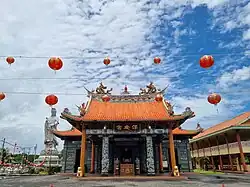Satya Dharma Temple
Vihara Satya Dharma (Chinese: 保安宮) is a modern Chinese temple at Benoa Port, Bali. It is a temple of the Three teachings ("Tridharma") of Chinese folk religion, i.e. Buddhism, Taoism, and Confucianism. Furthermore, like the other Chinese temples in Bali, this temple also has an altar in its outdoor yard dedicated to Gods of Balinese Hinduism.[1]
| Vihara Satya Dharma | |
|---|---|
 View of Temple | |
| General information | |
| Type | Chinese temple |
| Architectural style | Chinese style |
| Location | |
| Address | Pelabuhan Benoa Street 108, Benoa, Bali |
| Construction started | 2006 |
| Completed | 2012 |
| Inaugurated | Wednesday, August 15th 2012 |
| Cost | 3-4 Billions Rupiah[1][2] |
| Dimensions | |
| Other dimensions | Building 800 m2 Area 8200 m2[1][2] |
| Technical details | |
| Floor count | 1 floor |
The main deity of this temple is Tian Shang Sheng Mu, the Goddess who can calm the sea and ensure the safety of those travelling across the seas. As a temple which is built in the international port area, this temple worships the Deities of travel safety, sailing, and business. This is the first Chinese temple in Benoa Port thus is expected to be a worship place for the sailors from various countries and also as a tourist attraction.[2]
Naming
"Satya Dharma" (Sanskrit) means "True Law". "Vihara" is a Sanskrit term traditionally used for Buddhist temples in Southeast Asia, but it is also used occasionally for Chinese temples, otherwise called klenteng, since the New Order dispositions. Even though Confucianism has recently been accepted as a legal religion in Indonesia, many new Chinese temples in Bali still use the term "vihara" in their names.
"Vihara Satya Dharma" is translated in Chinese characters as 宮安保, from the right to the left readable as bǎo ān gōng. 保 (bǎo) means "to protect" while 安 (ān) means "content, quiet, peace", thus 安保 (ānbǎo) means "to maintain security". The 宮 (gōng) character means "temple, palace". Literally, Bao An Gong means the "Temple to Maintain Security".[3] It is a common term for any Chinese temples in Indonesia which intends the safety of its followers, especially in the spiritual meaning.
History
Vihara Satya Dharma is located at the north end of Benoa Port Highway. The temple foundation got the construction fund from the donation of worshippers from Indonesia especially Bali, even from Japanese, Taiwanese and Thai sailors. The construction lasted for 6 years until it was inaugurated in 2012. The inauguration celebration was held on 22 August 2012 and was attended by the Deputy Governor of Bali, i.e. AA Ngurah Puspayoga.[1][2]
Altars
| Number | Sing Bing (Deity) | Location | Information |
|---|---|---|---|
| Thian Kong | Terrace | ||
| 01 | Chie Ong Ya, Na Cha, Siong Ti Kong | The main front room (middle room) | Middle altar |
| 02 | Kwan Kong | The main front room (middle room) | Left altar |
| 03 | Ma Cho | The main front room (middle room) | Right altar |
| Ngo Yia Ciong Kun | Right wing | ||
| 01 | Kwan Im Put Co | The main back room (middle room) | Middle altar |
| 02 | Thai Sue Ya | The main back room (middle room) | Left altar |
| 03 | Seng Ong Ya | The main back room (middle room) | Right altar |
| 04-05 | Toa Ya Pe dan Ji Ya Pe | The main back room (middle room) | Flank Seng Ong Ya |
| 01 | Toa Pe Kong | Left wing back room | Middle altar |
| 02 | Te Con Ong Po Sat | Left wing back room | Left altar |
| 03 | Cin Cui Co Se | Left wing back room | Right altar |
| 04 | Tei Ki Co | Left wing back room | Under Te Con Ong Po Sat |
| 05 | Pei Ho Ciong Kun | Left wing back room | Under Cin Cui Co Se |
| 01 | Cu Seng Nian Nian | Right wing back room | Middle altar |
| 02 | Ong Ya Kong | Right wing back room | Left altar |
| 03 | Niu Niu (女娘娘) | Right wing back room | Right altar |
| 令 | Front yard | Under the flags |
Gallery
 The altar to Tian
The altar to Tian
See also
- Kim Tek Ie Temple (金德院), Jakarta
- Vihara Bahtera Bhakti (安卒大伯公廟), Jakarta
- Boen Tek Bio (文德廟), Tangerang
- Tay Kak Sie Temple (大覺寺), Semarang
- Sanggar Agung (宏善堂), Surabaya
- Hoo Ann Kiong Temple (護安宮), Riau
- Ban Hin Kiong Temple (萬興宮), Manado
- Gunung Timur Temple (東嶽觀), Medan
References
- Pemerintah Provinsi Bali (23 August 1012). "WAGUB PUSPAYOGA RESMIKAN VIHARA SATYA DHARMA". Archived from the original on 6 March 2016. Retrieved 23 October 2015.
- gds; nrl (23 Aug 2012). "Warga Tionghoa Bali Resmikan Vihara Satya Dharma". Retrieved 23 October 2015.
- MDBG Chinese Dictionary http://www.mdbg.net/chindict/chindict.php. Retrieved 23 October 2015.
{{cite encyclopedia}}: Missing or empty|title=(help)